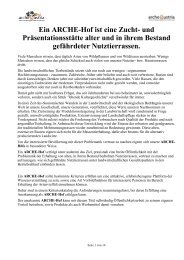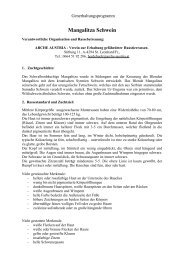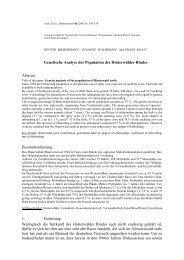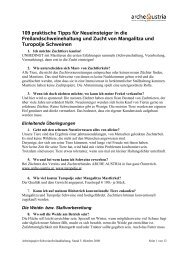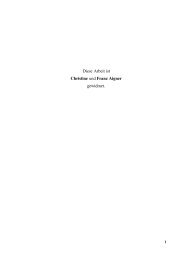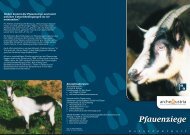Alte Rassen Ziegen u. Schafe o.T. - Arche Austria
Alte Rassen Ziegen u. Schafe o.T. - Arche Austria
Alte Rassen Ziegen u. Schafe o.T. - Arche Austria
Sie wollen auch ein ePaper? Erhöhen Sie die Reichweite Ihrer Titel.
YUMPU macht aus Druck-PDFs automatisch weboptimierte ePaper, die Google liebt.
SUMMARY<br />
1. From 1955 many alpine pastures were abandoned and the importance of milk yield in<br />
autochthonous goats decreased in pursuance of the mechanization of agriculture. This eco-<br />
nomical change did not obtain to rare goat breeds as long as they were allowed to feed in their<br />
traditional environment. Over the next thirty years many alpine pastures, which were feeding<br />
habitats of goats before, became hunting-grounds with excluding goat presence. At this time,<br />
at the late eighties, policy first estimated livestock biodiversity as genetic resource and as<br />
public good. Hence subsidies were established.<br />
2. Local denomination of the Grey-Black-White Mountain Gout (“Peacock” Goat) and old<br />
photos of this breed and of the Grisons Striped at alpine pastures in Salzburg refer to their<br />
autochthonous breeding in <strong>Austria</strong>.<br />
3. In alpine pastures the favourite food of mountain goats is composed of Vaccinium sp., Cal-<br />
luna vulgaris, brushes like Alnus alnobetula, Salix sp., leafs of ash-trees (Fraxinus excelsior),<br />
but goats also need grass and herbs. Heath vegetation, brush leaves and herbs have equal<br />
share in three fourth of food; the residual part is composed of grass and conifers. According to<br />
this feature, goats may be used as biological control of undesirable brows without exterminat-<br />
ing certain rare plant species. Grazers like sheep do not feed deciduous plants in the same<br />
quantity.<br />
4. Alpine rare goat breeds are well adapted to the ecological conditions of the Alps. This<br />
study gives instructions how to get them used to a home territory without shepherd. In exten-<br />
sive stock domesticated goats do not disturb game nor dispute the feeding resources. The tra-<br />
ditional summer environment is more prosperous for mountain goats than enclosed pasture.<br />
5. A farmer can get from 16 % to 25 % of the average revenue of an alpine farm from rare<br />
goat husbandry. From subsidies he may obtain about 36 % to 48 % of the income from goat<br />
production. About 55 % of the alpine goat farmers have sources of income from environmen-<br />
tally produced (“biological”) food.<br />
6. The best option for breed conservation of small ruminants is in situ. Autochthonous rare<br />
breeds of goats and sheep cannot maintain without preserving their traditional environment<br />
and without the socioeconomic survival of alpine farmers. Agriculture in so called “marginal<br />
areas” is suspected to require public subsidies in future.<br />
113



